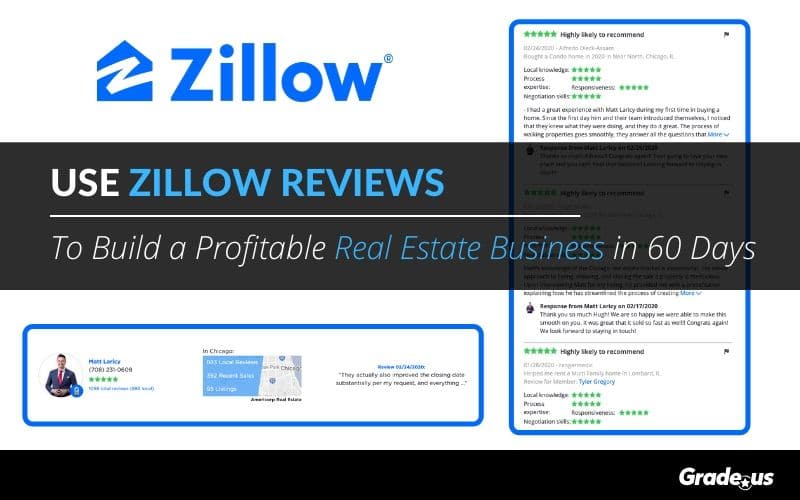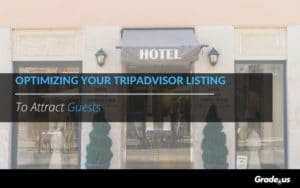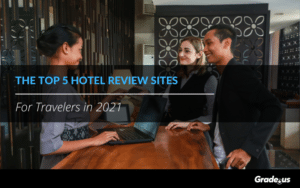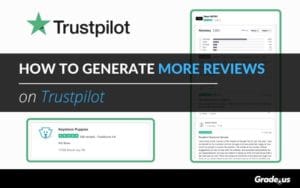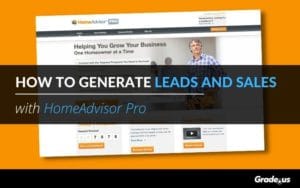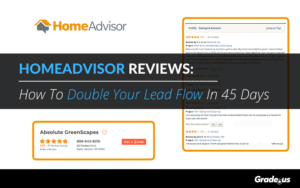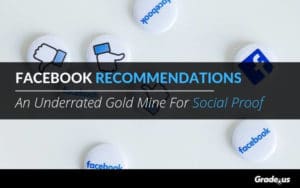When people are looking for a realtor to help them buy a house, chances are they’re visiting Zillow and reading your Zillow reviews. When it comes to the world of real estate, they’re a powerhouse.
The bad news? Many of your competitors are on their platform. The good news? Most of your competitors don’t know how to use their platform properly.
Zillow is a power broker.
You can use their platform to rapidly attract and convert new clients, the kind of high-value clients your real estate firm needs to scale growth. But to do that, you need a plan. We’ll show you how to achieve that in 60 days using Zillow, Zillow reviews, and other strategies.
Here’s what we’ll cover today:
Table of Content
Why Zillow is important to your real estate business
Zillow is the leading real estate marketplace. Users can search for real estate, apartments, mortgages and property values on their platform. Here’s why Zillow is so important to your business.
- Acquisitions: Zillow acquired Trulia, StreetEasy, HotPads, and nine other real estate brands. This gives Zillow significant reach which means you have a significant reach through each of their platforms.
- Reach: According to Statista, Zillow, via its website and Trulia, controls the majority of the online real estate marketplace.
- Inventory: The majority of homes in the U.S. are listed in Zillow’s U.S. database. They have a significant amount of public and proprietary information on home sales, properties, values, etc. Their public and proprietary data make their data set unique.
- Users: Zillow has a massive number of active users. Their users have updated information on more than 80 million homes. These home profiles aren’t available anywhere else. This user database provides them with a treasure trove of unique data – behaviors, habits, sentiment, buying/selling signals, etc. Why is this important? This data means Zillow knows your customers better than you do.
Let’s take a look at some of the reasons behind their tremendous value.
- Zillow receives 194 million monthly unique users (as of Q2 2019)
- Their platform has a $10.45 billion market cap, as of February 11, 2020
- Their annual revenue exceeds $1.3 billion+
- Zillow has 110 million homes listed in its database, out of 128.58 million homes total (as of 2019)
- Nearly 41% of people who visited Zillow and Trulia in the past 12 months are planning to buy or sell a home in the next 12 months
- 80% of all homes in the U.S. have been viewed on Zillow
- Zillow Rentals is the largest rental network on the web (as of July 2019)
- 75% of Zillow visits come from mobile devices
- 70% of Zillow's weekend visits arrive via mobile devices
- 186 homes viewed per second on Zillow via mobile
- Zillow generated 16.9 million leads to Premier Agent Advertisers
- Zillow's click conversion performs 3.4x better than clicks on Google
- Zillow has more than 2 million consumer-submitted real estate agent and mortgage lender reviews
If you’re a real estate professional and you aren’t on Zillow, you’ve already fallen behind. Almost all of the properties and the majority of users in the U.S. come to Zillow for real estate needs.
Who uses Zillow?
Zillow consumers can be broken down into four distinct groups – home buyers, homeowners, home sellers, and renters. These three users have their own set of desires, goals and motivations.
1. Homebuyers are young, educated and diverse. Zillow defines home buyers as “people who moved into a home that was purchased within the last year, which includes the main decision-makers and household members who had a say in the decision.”
- 75% are White, 11% Latino/Hispanic, 7% Black/African American, 5% Asian/Pacific Islander, 2% other
- 42% are millennials, 31% Gen X, 16% Baby Boomers, 10% Silent Gen
- 75% of all buyers have a college degree
- The median age is 36
- The median income is 87.5K
- 35% of home buyers are female, 65% male
- 77% of all buyers are married or partnered
- 47% are first-time homebuyers
- 54% are repeat buyers
- 86% of all buyers co-shop for a home
- Buyers spend 4.2 months on average shopping for a home
- Types of homes considered: Townhomes (20%), Condos or co-op housing (13%), duplex or triplex buildings (9%) and mobile or manufactured homes (8%)
According to their research, Millennials are housing flexible; they’re willing to look at any type of home (in any condition if they’re budget-conscious). Gen X buyers are least interested in condos and co-ops. Boomers show the highest interest in manufactured housing, while Silent Gen buyers are less interested in single-family homes.
Nearly half (48%) of all buyers consider homes that have never been lived in before.
Here’s the caveat.
More than half of all buyers (52%) considered renting instead of buying a new home. This includes repeat buyers, which is surprising. Here’s a bit of good news. As buyers age, their interest in renting declines.
2. Homeowners are typically married, educated, and mid-career. Zillow defines homeowners “as people who own their home and have lived there for more than a year.”
- 77% are White, 9% Latino/Hispanic, 9% Black/African American, 5% Asian/Pacific Islander, 1% Other
- 64% of homeowners have a college degree
- Live in households earning above $75K per year
- The median age is 52
- The median income is 62.5K
- 35% Are Baby Boomers, 29% Gen X, 20% Silent Gen and 16% Millennials
- 49% of homeowners are female, 51 percent male
- 77% of homeowners are married or partnered
- 52% live in the suburbs, 23% in an urban setting and 25% in a rural setting
3. Home sellers are educated, married, and new to selling. The vast majority of sellers today are listing their homes for the first time. This is typically due to a life change e.g., divorce, job change, empty nest.
- 72% are White, 11% Latino/Hispanic, 9% Black/African American, 6% Asian/Pacific Islander, 2% other
- Sellers typically upgrade with an additional 100 square feet and an 11 percent more expensive home
- Baby Boomers remain in the same size home
- The Silent Generation tends to downsides to a smaller home by an average of 220 square feet
- The median age is 41
- 37% are repeat sellers
- 80% engage in co-selling, sharing the selling role with another person
- 38% are Gen X, 26% Millennials, 18% Boomers, 19% Silent Gen
- Gen X and Millennial seller-buyers are looking for more space 23 percent and 25% more square footage
- The median income is 87.5K
- 32% of home sellers are female, 68% male
- 76% of all buyers are married or partnered
- 79% of all sellers have a college degree
What are the key events driving home sales?
- A job change (26%)
- Change in financial status (24%)
- Retirement (16%)
- Increase in size of household (14%)
- Change in school status (11%)
- Change in marital status (10%)
- A decrease in household size (9%)
4. Renters, most earn less than 50K. Zillow defines renters as people who moved to a “home that they rent within the last year, which includes the main decision-makers and other household members who had a say in the decision.”
- 52% are White, 19% Latino/Hispanic, 17% Black/African American, 9% Asian/Pacific Islander, 3% other
- The median age is 32
- The median income is 37.5K
- 61% of Boomers who rent are women; most bring in below 50K
- Nearly a third (29%) earn above 75K per year; they represent the highest portion of wealthier renters among the generations
- 48% are looking for single-family homes, 32% for townhomes, 24% for duplexes and triplexes, 17% for condos or co-op housing, 7% for a room in shared housing, 7% for an income-restricted home
- 56% are Millennials, 28% Gen X, 12% Baby Boomers, 3% Silent Gen
- 57% of renters are female, 43% male
- 55% of all renters are married or partnered
- 51% of all renters have a college degree
- 51% of renters are looking for apartments in small-to-medium size buildings
- 82% of renters are co-shopping for a home with either a romantic partner (53%) or a roommate-to-be (23%)
- 88% of renters below the age of 24 are searching for a home to share
Renter desires vary by location.
- 58% of northeast renters are likely to seek out small apartment buildings or rent a room in a shared home (10%)
- Southeast renters seek space, searching for single-family homes (53%) or townhomes (35%)
- Midwest renters search for duplex/triplex housing (29%). They're also among the most interested in single-family homes (50%) and smaller apartment buildings (41%)
- Southwest renters are interested in larger apartment communities (53%) or renting a condo or co-op (20%)
- Western renters are considerably more interested in small-to-medium-sized apartment buildings or living in a room in a shared home (10%) or an income-restricted property (9%)
- 58% of all renters are in the market for a new rental home but are also considering buying a place
Here’s what’s interesting.
There’s a significant degree of variance here, but the majority of these four groups converge towards a single goal.
Buying a home.
What makes Zillow so special? Why do so many people feel Zillow is the best place to shop for a new home?
How Zillow compares to other review platforms
Zillow is a mainstream platform, especially when you factor in their recent acquisitions. Here’s how their site compares with other mainstream platforms.
See what I mean?
Zillow users are more engaged; their bounce rates are comparable to the big three, which is saying something. Zillow receives most of its traffic from direct sources (e.g., mobile apps, direct visits) but they also receive a significant portion from search.
If you’re in real estate, Zillow is the place to be.
If you’re a real estate agent/broker, lender or loan officer, property manager, builder, or real estate themed advertiser, Zillow can add significant value to your business. Zillow’s network of real estate sites gives you direct access to the millions of people searching for a home.
What should your goals be on Zillow?
After a buyer contacts an agent, they return to Zillow an average of 27 times and visit 77 listing pages in 30 days. This is phenomenal, but it’s also a wonderful way to establish yourself as the agent of choice.
- Branding: With effective branding, you become the agent customers see everywhere. You boost your reputed and presumed credibility as a result. A strong brand means you're able to attract more leads, close more deals and make more money in less time and effort. Branding in this sense is akin to reputation, the acknowledgment that you stand for something good.
- Online visits: These are visits from your Zillow profile to your website, landing page or social media profile. If you're looking to generate leads and win customers with online visits, you'll need to ensure there's a significant amount of relevance between your Zillow profile and your real estate landing page.
- Phone calls: If you're part of Zillow's Premier Agent program, they'll connect you with interested prospects directly. This is an excellent way to win clients over. A shopper reaches out via Zillow's platform while viewing a listing. Zillow support contacts the customer to verify their interest then connects you to the shopper directly.
- Leads: Contact information from a qualified prospect via Zillow's Premier Agent program – someone who's interested, willing, and able to retain your services. It's important to disqualify prospective clients as much as you can as clients aren't created equal. Experienced attorneys and law firms understand the business development process is essentially a mutual interview.
Isn’t sales a worthwhile goal?
It is, but closing a deal is between you and the customer. This portion of the deal isn’t an area that Zillow facilitates though this is expected to change in the future.
Claiming or creating your profile on Zillow
Creating a profile on Zillow is a bit tricky; some of the onsite options are unclear. To get started, just follow the steps below.
1. Head over to PremierAgent.Zillow.com/products/agent-account/
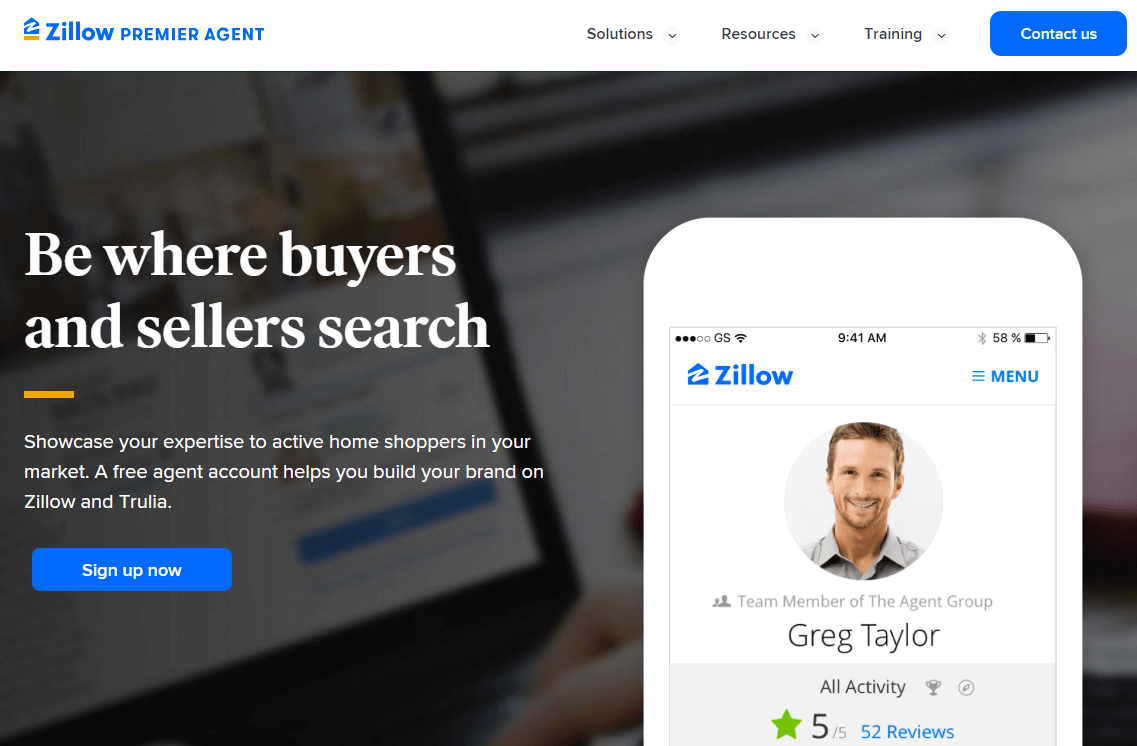
2. Click sign up now.
3. Enter your email address and password.
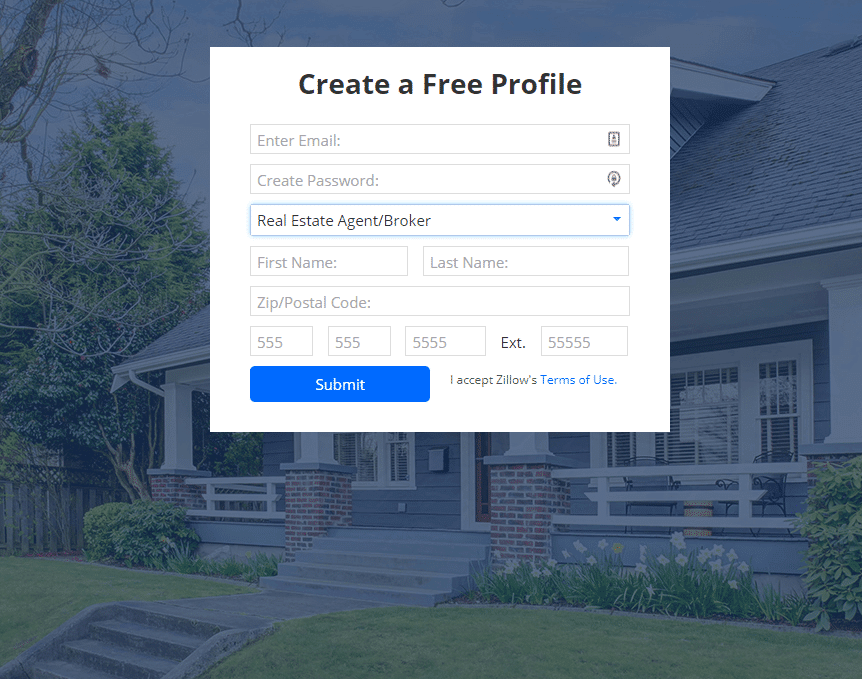
4. Select your profession from the list. Then enter your name, phone number, and extension.
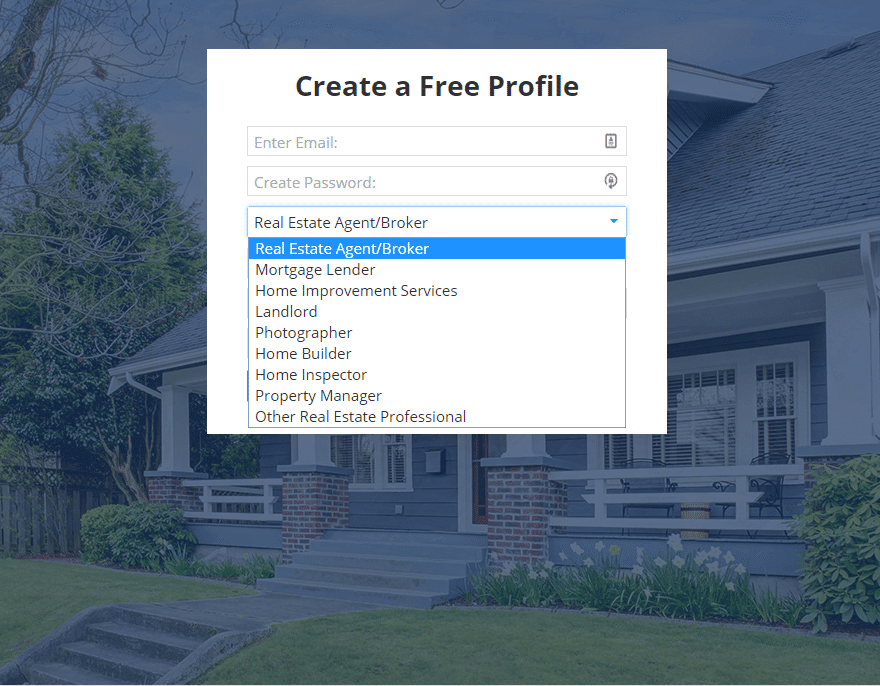
5. Follow the prompts to begin completing and optimizing your profile.
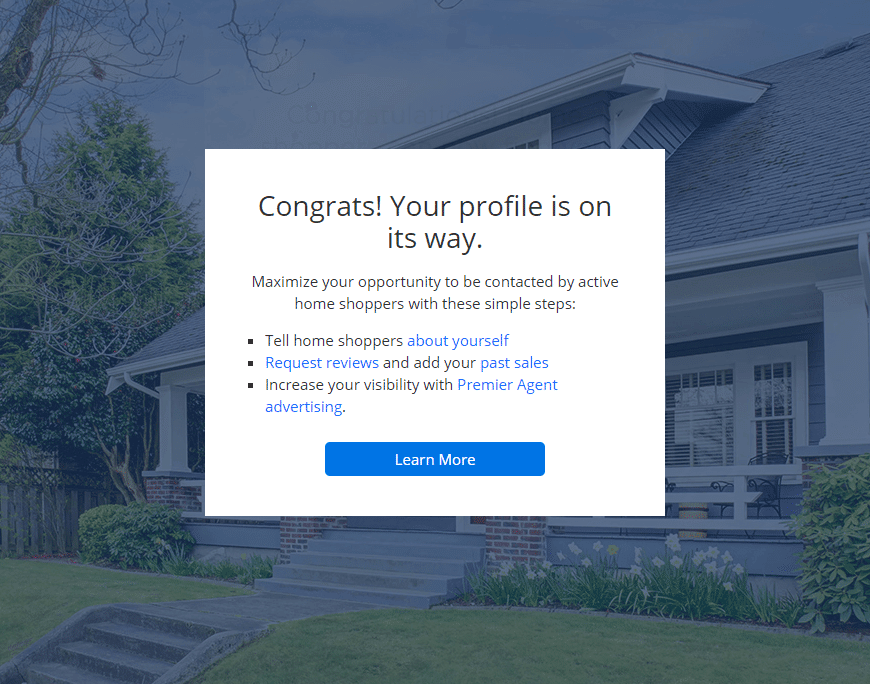
6. Edit your profile information by completing Zillow’s form. This form is comprehensive – you’ll need to provide Zillow with your business, personal, and contact information. You’ll also need to include a valid real estate license with your profile.
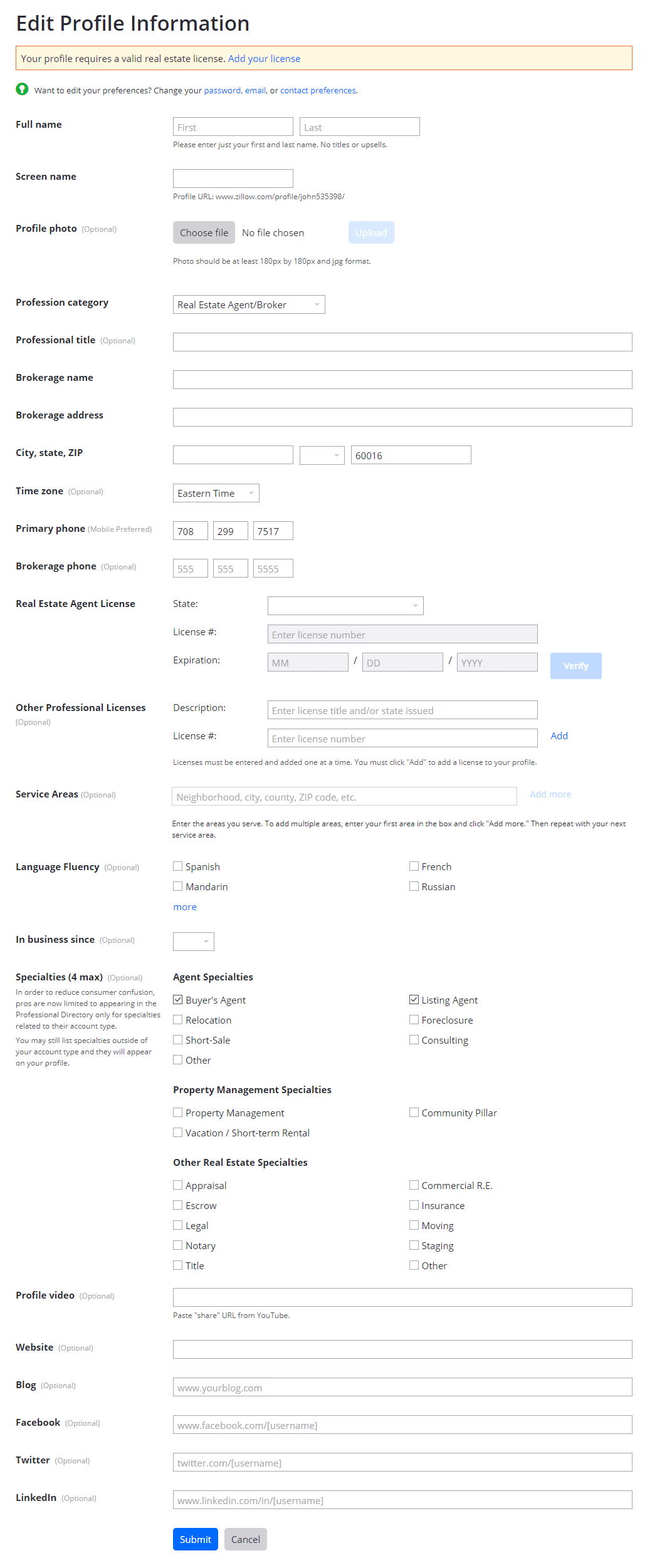
7. Click the “Request Reviews” link in step five to make a request.
8. Enter past client email addresses, then fill out their review request form and click “Send Request.”
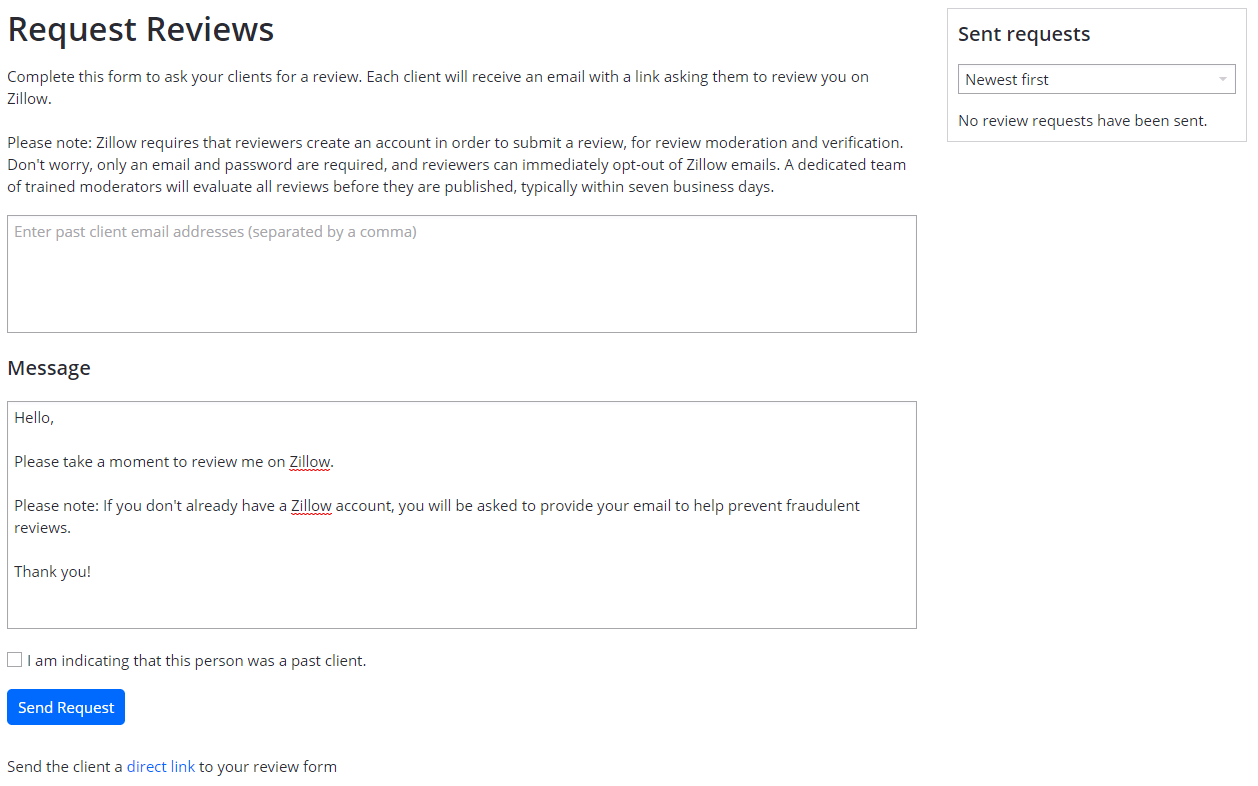
They could be a bit more clear on this, but it’s simple enough to find if you do some digging. You’ll want to complete your profile first, then gather email addresses from your past clients so you can make review requests. Doing this upfront legwork means it’s easier to optimize your profile later.
Optimizing your Zillow profile
Here’s a video from Zillow that will walk you through the process of optimizing your Zillow profile.
Emily at Zillow suggests using the acronym S.H.A.R.P to optimize your Zillow profile. Let’s break this acronym down to learn more.
- Sales: You’ll want to list your recent sales on your Zillow profile, as doing so displays your local market expertise. It also provides indisputable evidence that you’re an in-demand agent or broker. Post every transaction, starting with the 12 most recent ones. Here are some instructions showing you how to do it.
- Headshot: Emily recommends getting a professional headshot taken as this conveys key details about you. Your headshot conveys intangible details about you, your business, level of professionalism, and tone. It’s an implicit tool that draws like-minded clients to you.
- Advertising markets: This is also known as your service area. Add all of the cities, towns, neighborhoods, and zip codes of areas that you serve. This ensures that you show up in the agent directories whenever a home shopper searches for a professional in your market.
- Reviews: Sixty-two percent of buyers choose a real estate professional based on online reviews. Buyers worked with an agent 87 percent of the time to find their home. Google says 49 percent of real estate consumers search for trust, followed by experience, negotiation, personal references, speed, and brand. A strong review portfolio increases customer trust considerably. Be sure to follow Zillow’s best practices when requesting reviews.
- Professional bio: This is also known as your about me section. Use this section to highlight specialties, expertise, credentials, accomplishments, memberships and awards. Give home shoppers a compelling reason to choose you. Zillow offers a professional bio template you can customize for your business.
What if you’re a broker managing a team of agents in your office?
No problem!
Here’s how you create and manage a team profile on Zillow.
What does this look like in action?
A quick look at 8z Real Estate will show us. 8z was listed as the “#1 rated brokerage in Colorado by Zillow.” What makes their profile so special?
8z Real Estate:
- Has over 2400 reviews
- A 4.95-star rating (5 is the highest rating)
- 1559 Agent reviews
- 1,100 sales in the last 12 months
- 65 current listings
- Only employs full-time Realtors
- Sold $10 million of real estate
Here’s a screenshot of their brokerage profile.
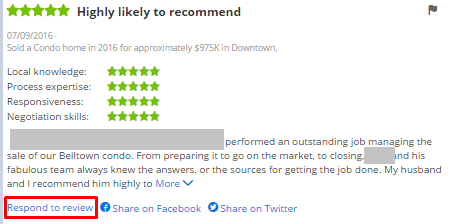
If you expand their list of Realtors, you see the same thing — dozens of Realtors with glowing reviews and a fully optimized profile.
It’s amazing.
Let’s look at the profile of Aimee Quaratino, an 8z Realtor.

Outstanding!
Let’s break Quaratino’s profile down to see what makes her exceptional.
1. Professional headshot: First off, Quaratino’s headshot is professionally done. Her headshot communicates professionalism at every level – there’s no inappropriate or suggestive posing, no bizarre filters. It’s crisp, clear and direct. She exudes confidence.
2. Activity: Quaratino has a phenomenal 5/5 aggregate rating across 54 reviews. This is an extraordinarily difficult feat to pull off.
3. About us: She understands the secret of an exceptional bio. Your bio isn’t really about you; it’s about your clients and the value you can provide. She uses an appropriate mix of credibility, prestige and authority signals to build shopper confidence.
4. Her listings: If you’re selling your home, this is what you want to see. She’s sold a large variety of homes in the metro area. This displays her experience, credibility and proven ability to achieve results. It’s an implicit, evidenced-based way to show shoppers that she is an all-star.
5. Active listings: She has one active listing shown. Depending on the reason, this could be a good or bad sign. Is she giving this property her undivided attention? Is her attention elsewhere at the moment? Why only one after selling so many homes? Has demand for her services cooled?
6. Past sales: This drills deeper into the results shown on the map above. It also shows that she’s a seller’s Realtor who can deliver results, across a variety of neighborhoods, price ranges and amenities.
7. Reviews: Wave after wave of glowing reviews from happy customers. Normally this isn’t as convincing except for the fact that there’s a difference here. The majority of her clients offer detailed insights in their reviews, demonstrating that she is, in fact, exceptional.
8. Service areas: Quaratino serves 11 different cities in Colorado. This is impressive as it requires a significant amount of time and energy to learn the ins and outs of just one town or city. This makes sense when you realize she has 19 years of experience in the industry as a full-time Realtor, impressive.
It’s difficult to fake these details.
Which is precisely why they’re so compelling when they’re added to your profile.
Responding to reviews on Zillow
Responding to reviews on Zillow is straightforward. Here’s how you do it.
1. To respond to reviews, first go to your profile page.
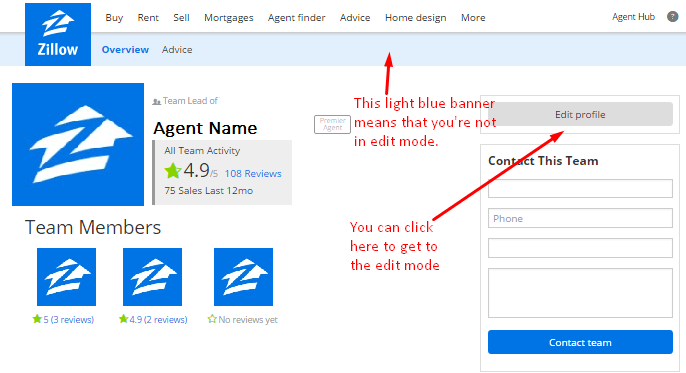
2. Scroll down to the review you wish to respond to.
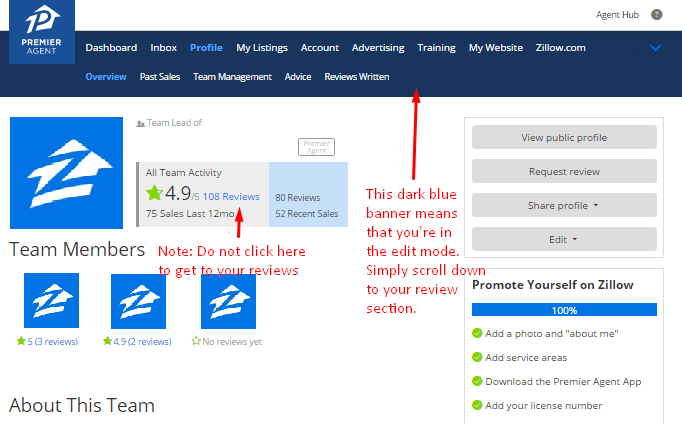
3. Below the details of each review, you can click “Respond to review” to write a public response to your client. Your response will be shown below the original review.

Zillow recommends that you respond to each of your reviews regardless of whether the review was positive, negative, or neutral. Here are 19 response templates you can use to do just that.
This is crucial because it sets the tone for future reviews. A calm, empathetic response to angry reviewers means you’re less likely to deal with combative reviewers who are looking to get a rise out of you. This attracts more of the right clients and less of the wrong ones.
Goal tracking via Zillow
If you’re a Zillow Premier Agent customer, you have access to their CRM tool. This is a wonderful tool because it helps you to segment and follow up with the leads you receive in your business.
This isn’t limited to Zillow.
You can import leads from more than 25 sources, including Homes.com, Realtor.com, IDXbroker, and others. Here are some of the significant features that come with Zillow’s CRM tool.
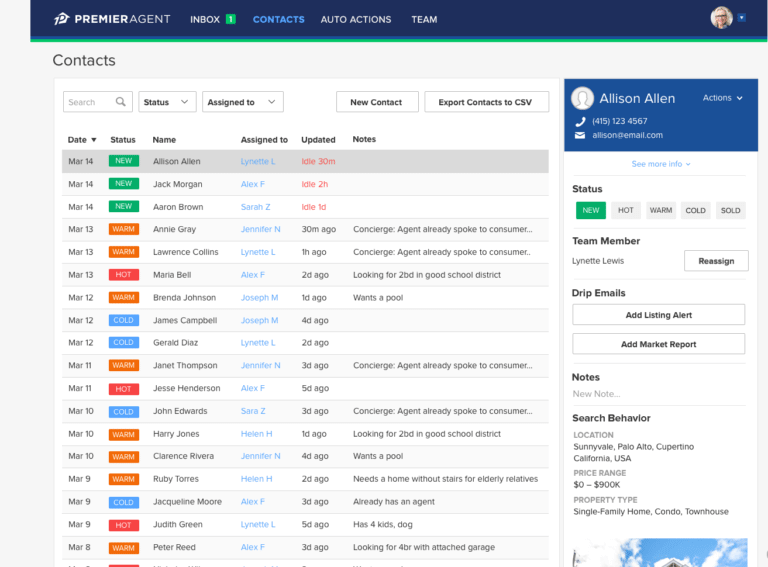
- Autoresponder: Create and send a series of messages that are delivered automatically on a schedule or in response to specific triggered events.
- Email templates: Create, save, and send email templates to respond to common questions, comments or concerns. Use this to help your support teams keep up with demand as your business grows.
- Lead forwarding: With Zillow, you can forward your leads to as many as three email addresses at once. This is perfect if you're looking to share leads with multiple people on your team who are responsible for following up with customers at a set time or date.
- Lead reporting: Detailed analytics showing you lead volume, performance, sources, price ranges, and quality over time. Don't think you're receiving high-quality leads, verify it with the data you receive.
- Lead routing: This is a feature that's exclusive to team accounts. Similar to forwarding, lead routing enables you to forward leads to different team members based on price, zip code, or freshness.
- Lead segmentation: Sort leads based on their position in your marketing funnel or sales pipeline. Score leads as hot, warm, or cold - then segment and sort based on lead status.
- Push notifications: Officially known as "Instant Alerts," this Zillow feature sends you an alert the second a lead comes in, sending a push notification to the Zillow Premier Agent app installed on your smartphone or mobile device.
Zillow’s primary focus, on the professional’s side, is lead generation. Their CRM tools are a helpful way to verify campaign performance. Some of the features listed require investment but it’s worth it for one simple reason.
Zillow receives more than 80 million+ page views per month.
Your Zillow point-of-contact
Zillow offers several ways for real estate professionals to get in touch.
- Web: Zillow Help Center
- Phone: 206-470-7000
- Email: [email protected] or [email protected]
- Twitter:
- Facebook:
This is significant, because it’s uncommon.
Most review platforms don’t provide customers with straightforward contact channels. There are lots of hoops to jump through on other channels.
Advertising on Zillow
Almost every single home buyer or seller in the U.S. uses Zillow at least once during their search for a home. This means sense because Zillow has 80 percent of U.S. properties in their database, remember?
Here’s a list of their advertising programs.
Zillow Seller Boost
According to Zillow:
“Seller Boost is a new program that connects Premier Agents with highly interested seller leads: homeowners who have indicated they are looking to sell and choose to contact an agent on Zillow or Trulia. The program is an add-on to your existing Premier Agent advertising; when you participate in Seller Boost, listing leads appear in your Premier Agent Inbox alongside your buyer leads, and they are clearly identified so that you can see at a glance what kind of leads you’re receiving.”
Seller boost keeps your sales funnel full and offers the potential of doing more than one transaction with the same client.
Zillow Featured Listings
With featured listings, your listing receives maximum visibility in Zillow’s search results. This is good news for your clients as it helps to generate more interest and desire in the marketplace. Even better, your profile receives extra exposure on those listings as the exclusive, sole agent to contact – no other agents are listed.
“After working out details with your sellers, you can post Coming Soon Listings before they hit the market to gauge buyer interest. As a Premier Agent, you can get a head start on your marketing and sell homes faster.”
Zillow Premier Agent
This service is billed on a per lead basis (typically anywhere from $20-$120 per lead). Here’s how it works. If you’re a Premier agent and you’ve submitted a listing, you’ll be listed as the real estate agent next to the property details. For listings submitted by non-Premier agents, you’re listed as one of three agents below the actual listing agent.
This is huge.
This means any listing in your service area is a potential lead source for your business. If your Zillow profile is optimized, this means you may generate more leads on your competitor’s listing than they do!
Zillow Premier Agent Ads
Advertising by Zillow works similarly; a shopper on Zillow or Trulia makes an inquiry while viewing a listing. Zillow contacts and verifies the lead on your behalf. They call you and introduce you to the shopper, enabling you to attract and win new clients.
Here are some additional details provided for Zillow Premier agent ads:
“When you have a My Agent relationship with a client, you’re the only agent they’ll see. You’ll also get information on the homes they search for, view, and save, keeping you one step ahead.”
Zillow Premier Agent Direct
“Premier Agent Direct allows you to promote your listings and brand online by combining the reach of Zillow and Facebook. With Premier Agent Direct, you get premium ads on high-traffic Zillow search results pages that showcase your listing, video, or profile. You also get personalized ads on Facebook that are targeted at Zillow’s audience of high-intent buyers and sellers.
Also included with Premier Agent Direct is a professionally shot video that you can use on your Zillow profile, Premier Agent Direct ads, and email autoresponders to clients. Our Agent Care team schedules the video shoot as part of the purchase process.”

1. Homebuyers shop online
2. Views your neighborhood on Zillow and Trulia
3. Sees your ad on Facebook
4. Clicks to your custom landing page
5. Greater conversion
Program pricing varies based on location ranging from $300-$5000 per mo.
Premier Agent Concierge Program
This program is offered to select brokerages and teams on Zillow, here’s how it works. Zillow’s Premier agent concierge team calls, emails or texts your leads to verify them. You receive these leads once they’re vetted and approved; new leads are entered into your CRM system and graded according to lead status (i.e., hot, warm, cold, etc.).
Customers typically receive follow-up from Zillow in a few minutes.
Zillow also offers advertising in the following areas:
Your step by step real estate business building plan
Here’s the problem for most real estate professionals. From the very beginning of their careers, real estate professionals are trapped in a vicious cycle.
- They don't have any money
- They have zero leads
- They have little to no connections
- They don't understand sales and marketing
- They don't know how to sell or market themselves (not really)
It’s no surprise then that most newcomers are out of the industry within five years. Here’s how you can build a profitable real estate business with Zillow reviews in 60 days.
Step #1: Create and claim your review profiles
You’ll want to create or claim your review listings on mainstream sites like Zillow, Trulia, Google, Yelp, Realtor, Movoto, Homes.com, and other industry-specific sites. Review management for the real estate industry absolutely needs to be on your radar.
If you’re a broker, you’ll want to create profiles for your business, yourself, and each agent in your brokerage. If you’re an agent, create a profile for yourself on both review and listings sites. Syndicate your listings across the variety of sites I mentioned above.
Step #2: Create a compelling value proposition
Your value proposition answers one specific question. Why should I buy from you, specifically? Your value proposition has four essential ingredients.
1. Appeal – I want it
2. Exclusivity -I can’t get it anywhere else
3. Clarity -I understand you
4. Credibility – I believe you.
This is the most difficult part of the process. It’s also the part most real estate professionals will skip. Don’t do it. Stick with it until you’ve created a compelling value proposition that includes all four ingredients.
Step #3: Create multiple irresistible offers
An irresistible offer provides your target audience with the overwhelming incentive they need to take action on your offer. Examples include:
- Discounts - 90% off
- Bonuses - a free lifetime subscription to XYZ service
- Vanishing or limited offers - be one of the first 10 callers today and you'll receive
- Guarantees - I'll get your deal funded, guaranteed
- Exclusive offers - become the neighborhood information broker. Offer it as a free subscription to your current and past clients. Share information on the goings and comings, crime, changes, updates, deals, and gossip in a particular neighborhood.
Create an irresistible offer for both your prospective clients and tangential sources. Post your value proposition and irresistible offers (for prospective clients) on the profiles you’ve created or claimed. You can share these details in your descriptions, as image snippets, or links to specially tailored, offer specific landing pages on your website.
Step #4: Partner with tangential sources
Make a list of the clients you want (e.g., luxury, commercial, or first-time homebuyers). Next, identify the professionals who have said clients in their portfolios. It’s the absolute worst thing you can do as it tells your competitors, other agents, that you’re coming.
If you’re a Realtor, don’t reach out to other realtors or real estate agents. Find and meet with tangential professionals – mortgage brokers, appraisers, home inspectors, title companies.
Tell them you can resurrect their dead leads, that you can put 40% to 60% more money back into their pocket without any additional effort on their part.
Expect a healthy degree of skepticism. Work to minimize their risk.
Step #5: Resurrect their dead leads
Ask each of these professionals to share a list of their dead leads, prospects they’ve contacted in the past but failed to close for one reason or another.
Tell them you’d like to help them close these lost customers. Let them know you’ll do all the legwork, keep them updated on your progress, and alert them when it’s time for them to step in and help you close the sale. If you’ve done this right, you should be flooded with leads from a variety of sources.
Step #6: Create a resurrection sequence
If you’re a Zillow Premier Agent, plug these dead leads into your Zillow CRM tool. A resurrection sequence is nothing more than an autoresponder sequence that’s designed to grab and hold the attention of an inactive prospect. Your resurrection sequence has a specific set of details included in each message.
- An irresistible offer
- A genuine urgency trigger or incentive to act now
- A clear and unmistakable way for these prospects to opt-out
Your communication should include these three ingredients regardless of the channel used (e.g., email, text message, phone call, social media, etc.).
Hit this tactic aggressively, and you should be flooded with leads in 30 days with deals closing consistently in 60 to 90 days. Combine this tactic with your Zillow profile and you’ll see results even faster. Utilize parallel advertising of your own on Google or Facebook and you’ll be seen everywhere.
Request reviews from every client you close.
You can use email request reviews campaigns from each of your tangential sources once you’ve delivered exceptional results for their business. Send them to your Zillow and review profiles to boost your profile further.
Zillow is a real estate powerhouse
The vast majority of your competitors are on their platform. This is very good news as most of them don’t know how to use Zillow properly.
You do. You understand the hidden power of their platform.
You now know how to use their platform to rapidly attract, acquire, and win the kind of high-value clients your real estate firm needs to grow. No money, zero leads and connections? No problem! You can generate a significant amount of business in 60 days or less. Zillow is the leading real estate marketplace. Use their platform well and you’ll find you’re the real estate powerbroker your clients desperately need.

